Unprocessed FAQ: Chocolate
Oct 06, 2019
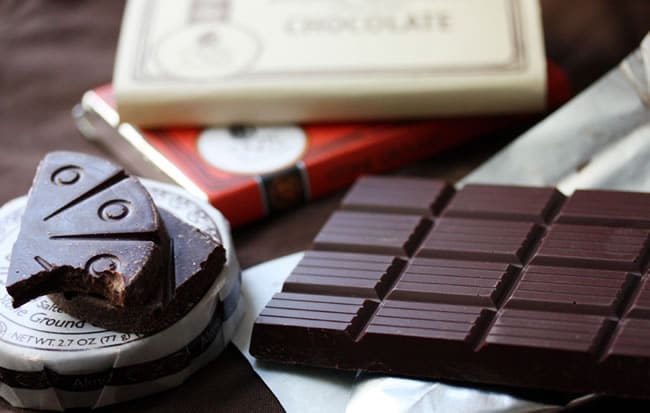
Hundreds of people have now taken the October Unprocessed challenge! If you haven’t taken the pledge yet, please do it today. (If you already eat this way all the time, take the pledge and show your support! And if you think it’s too daunting, how about just for two weeks? Or even a day? Do what you can, and take charge of your health!) … We’ve got a lot of momentum, and this is turning into something really powerful. Keep it up–and bring your friends!
—
Another of the most commonly asked questions about October Unprocessed and the Kitchen Test is, you guessed it: Chocolate.
There are a ton of different types of chocolate products, of course, and it can be tough (or at least tedious) to figure out which store-bought versions actually pass the kitchen test.
In theory, at least, chocolate is one of those unprocessed foods that easily passes the test. If you knew what you were doing, you could grow cacao, harvest and ferment the beans, dry them, roast them, crack them into nibs, grind them into liquor, conch the liquor (mixing it for several hours), temper it, and then add some sugar and form it into a fabulous home-made chocolate bar.
Here’s a great, thorough walk-through of how chocolate gets from farm to you. It would probably take you two or three weeks to get through all of those steps, but again, you could do it if you really wanted to. If you are a brave soul who has actually done any of this, please tell us about it in the comments!
If you’d like a shortcut to fantastic homemade chocolate (starting from cocoa powder), don’t miss Desiree’s guest post on how to make chocolate.
Cocoa Powder
Cocoa Powder is the non-fat component of chocolate (the fatty component is called cocoa butter). Sometimes listed as cocoa solids, it may also be called cacao or just cocoa. On its own it passes the kitchen test easily. This is also the part of the cocoa that has the most minerals and flavonoids. In other words, it may very well be the healthiest part of the chocolate.
However, if you come across “Cocoa processed with Alkali” or “Dutch-Processed Cocoa” (same thing), that means that they’ve added an alkali (a base) to the chocolate to counteract some of the acidity. From a health standpoint, you’re better off finding cocoa powder that has not been processed with alkali — because that processing destroys most of the beneficial flavonoids.
It’s tricky to actually find exactly which alkali has been used to process the cocoa, since it’s not usually listed in the ingredients. Potassium bicarbonate seems to be the most common. Personally, I’m going to avoid any cocoa powder that has been alkalized.

Chocolate Bars
Most store-bought chocolate bars contain emulsifiers, flavorings, or other additives that you wouldn’t or couldn’t use if you were to make it at home.
Lecithin (usually soy lecithin) seems to be the most common commercial additive. It’s an emulsifier that helps keep the cocoa and the cocoa butter from separating, which helps keep it looking good, even after it’s been sitting on the store shelf for a while. While lecithin may or may not be “good” for you (I don’t think it’s been studied enough, and it’s certainly not necessary in our diets), you certainly wouldn’t make it at home: To make soy lecithin, it’s extracted from soybeans using hexane.
Almost all chocolate bars contain sugar in some form or another — otherwise it would be too bitter to enjoy. (You can find 99% chocolate bars which are used for baking, not snacking). We’ll need to apply the kitchen test on the specific type of sugar they use (some just list “sugar,” others will be more specific).
Other chocolate candies may, of course, add flavorings or preservatives other things that probably don’t pass the kitchen test. For those, you’ll need to read the ingredients list and apply the test to each one.
As a general guide, the larger the company, the less likely the chocolate bars will pass muster (he said, staring towards Pennsylvania). However, there are some commercially available chocolate bars that pass the test, and in my experience, the darker the bar (82% or 85%!), the more likely it is to pass.
In the years since we started October Unprocessed, more and more companies that focus on fair trade and social/environmental justice have appeared, and they’re more likely to skip the additives — and thankfully we can find them much more easily than before (Careful, though: the major brands have caught on. For example, The Hershey Company bought Dagoba in 2006.) Some brands I like: Theo, Alter Eco, Equal Exchange, Taza, Gnosis.
Here’s also a thorough blog post that lists bars they’ve found without soy products (those may still use other taboo ingredients, but it’s a good place to start looking), and you might also want to check out the Food Empowerment Project’s slavery-free chocolate list.
If you know of more chocolate bars that pass the kitchen test, please share in the comments.
White Chocolate
White chocolate is a candy that’s made with sugar, milk, and cocoa butter. There are no cocoa solids (cocoa powder) at all. This may pass the kitchen test, depending on the specific ingredients and where you draw the line for yourself. But just remember that the beneficial parts of chocolate are found in the cocoa solids, so don’t think that you’re getting any health benefit from white chocolate.
Milk Chocolate
Milk Chocolate is a solid chocolate that’s been made with “milk.” I put that in quotes, because it may be milk powder, liquid milk, or condensed milk. These types of chocolates usually have a lot of sugar — in the United States, they’re only required to have a minimum of 10% of chocolate liquor (European states are a bit higher, in the 20-25% range). My read on most store-bought milk chocolate is that it’s probably not going to pass the kitchen test.
Raw Chocolate & Cacao Nibs
“Raw” Chocolate is one that hasn’t been processed or heated to the same degree as “typical” chocolate (details on “raw” tend to be a bit sketchy, and vary with each company). Cacao Nibs (Cocoa Nibs) are the dried beans, usually broken into little pieces, and are sold either before or after roasting (much like any other seed or nut).
Both of these are probably your best bet for October. I love cacao nibs sprinkled on top of my oatmeal — they give a nice crunch, and have a mild chocolate flavor. They’re chocolate chips in the truest sense! (I like Navitas Naturals.)
—
I think that about covers it for chocolate — did I miss anything? Do you have any recommendations of store-bought chocolate that pass the kitchen test?
If you haven't taken the October Unprocessed pledge yet, please do! And then encourage your friends to join in -- it's a lot more fun that way!
Hershey’s Milk Chocolate Wrapper © 2014 Andrew Wilder, shared under creative commons license.
Cacao Nibs After De-Chaffing © 2012 Daniel Brock, used under creative commons license.
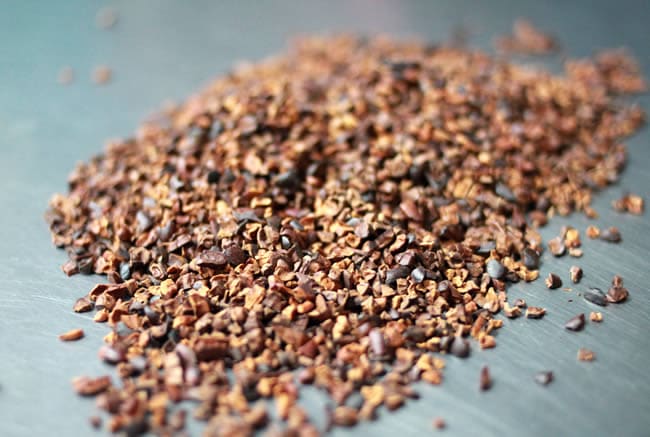
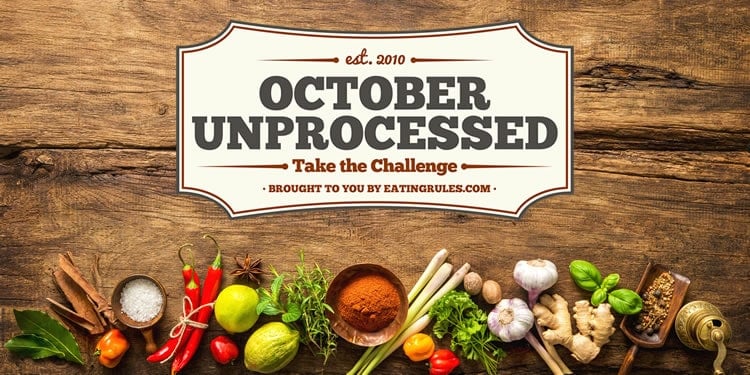


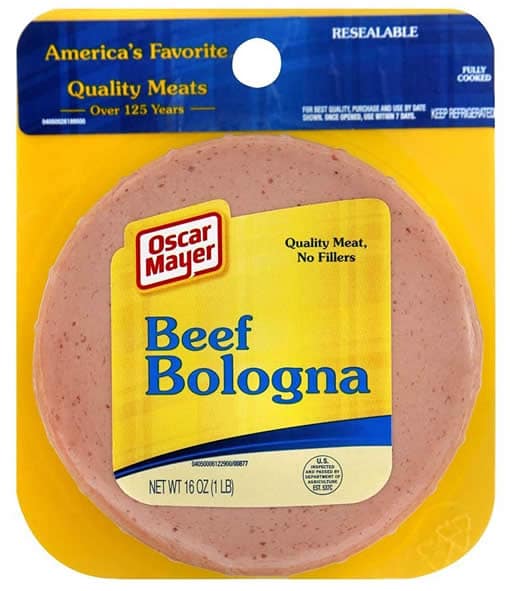
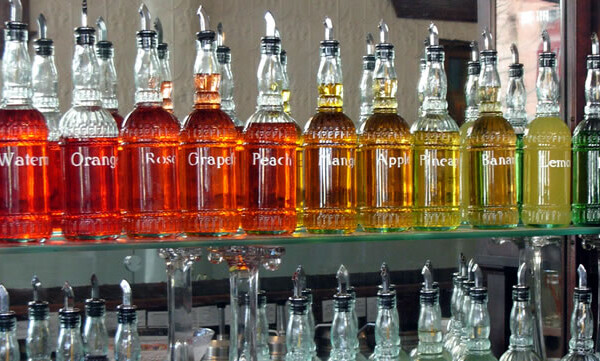
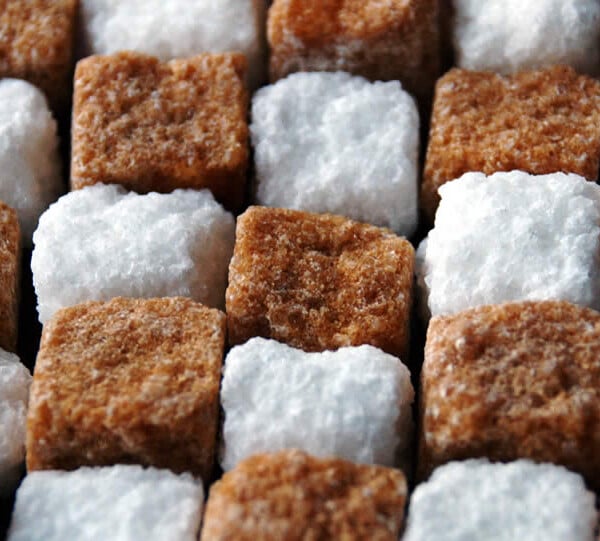
















There’s a local Chocolatier, Tabak Chocolate, who make unprocessed bars. They are based in Wisconsin, but can be purchased online at tabalchocolate.com. I have a bar of their chocolate + coffee variety in my desk at work 🙂 I also LOVE cacao nibs now! They’re great on oatmeal, chia pudding, and mixed with nuts and (unprocessed) dried fruits for a super powered snack mix. One bag can go the distance, as they’re bitter enough you don’t need too much to curb the chocolate cravings.
Edit: the brand is called Tabal* chocolate! Sorry!
This is the best chocolate story I have ever heard!
http://blogs.ntm.org/seth-callahan/2016/08/04/the-candy-man-can/
Andrew, I would suggest buying raw cacao powder vs. cocoa powder. Many of the amazing nutrients of cacao are destroyed when roasted at a high temperature, which is what cocoa is.
Cocoa is still a good choice, but if you are looking at the nutritional value of the product, cacao is the better choice.
I’ve found that Lindt 85% is probably the best that’s widely available.
What do you think about tempering home made chocolate with the freeze dried cocoa butter called Mycryo?
Interesting…hadn’t heard of the stuff before, thanks. Have you actually used the Mycryo for this? Their website makes it sound like it’s mostly for frying, not for adding back in to the chocolate?
http://www.mycryo.com/callebaut/en/about.html
If it’s freeze-dried, technically it wouldn’t pass the kitchen test, since you can’t really freeze-dry at home (it requires super-low temperatures under vacuum). So I’ll leave this one for you to decide!
Here is the link to where I learned of this technique. I was researching making chocolate Bean to Bar.
I hope that you’ll go over condiments as well. I make a trail mix using Sriracha sauce and it is seriously addictive. Is there an “unprocessed” Sriracha? So far I haven’t come across one and also don’t have time to make it. . .
The most popular brand (the one with the rooster) contains preservatives, so it wouldn’t qualify. So far I think the only major brand that makes a hot sauce that passes the kitchen test is original Tabasco. (There may be others, of course, but I haven’t found them!).
BUT, making Sriracha might be faster/easier than you think. Stay tuned next month to learn more! 😉
I hate Tabasco sauce (possibly because I detest pickled peppers and don’t particularly like the peppers they use), but maybe I could start there and add ingredients to make something like Sriracha. The Sriracha recipes that I have seen are all quite time consuming (need to ferment the peppers for several days/weeks; but sound really yummy!).
I was hoping that maybe there was a brand that was relatively unprocessed. I did see an organic brand, but didn’t look to see how unprocessed it was at the time. The trail mix is seriously addictive (almost as much as chocolate), thus, the question.
Frank’s Red Hot (“Buffalo flavor”) hot sauce also qualifies, unless I’m wrong about garlic powder. 🙂
What about Ghirardelli 100%?
From an unprocessed perspective, I would think that would be just fine (they list the ingredients simply as “unsweetened chocolate”). But from a taste perspective, you probably won’t want to eat a bar of 100% chocolate…
Thank you for this article. I don’t eat much chocolate but I can pass on the information to my choco-holic family and friends.
I understand that some chocolate bars contain ‘alkali-processed’ cocoa. Can you comment on these?
Not sure if this got mentioned already but Eating Evolved makes some damn fine chocolate with no crap in it. Some Whole Foods carry it but you can order online as well. The 100% dark is intense!